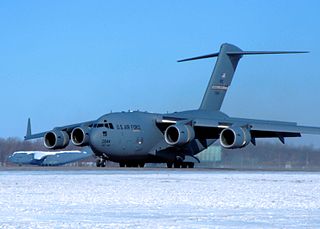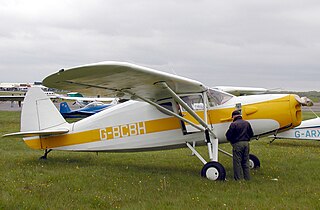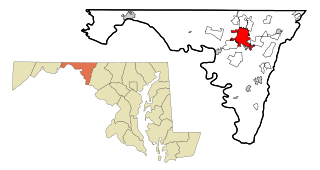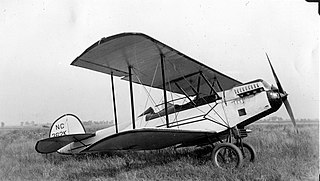
Wright-Patterson Air Force Base (WPAFB) is a United States Air Force base and census-designated place just east of Dayton, Ohio, in Greene and Montgomery counties. It includes both Wright and Patterson Fields, which were originally Wilbur Wright Field and Fairfield Aviation General Supply Depot. Patterson Field is approximately 16 kilometres (10 mi) northeast of Dayton; Wright Field is approximately 8.0 kilometres (5 mi) northeast of Dayton.

Fairchild was an American aircraft and aerospace manufacturing company based at various times in Farmingdale, New York; Hagerstown, Maryland; and San Antonio, Texas.

The Glenn L. Martin Company, also known as The Martin Company from 1917 to 1961, was an American aircraft and aerospace manufacturing company founded by aviation pioneer Glenn L. Martin. The Martin Company produced many important aircraft for the defense of the US and allies, especially during World War II and the Cold War. During the 1950s and '60s, the Martin Company moved from the aircraft industry into the guided missile, space exploration, and space utilization industries.

Selfridge Air National Guard Base or Selfridge ANGB is an Air National Guard installation located in Harrison Township, Michigan, near Mount Clemens. Selfridge Field was one of thirty-two Air Service training camps established after the United States entry into World War I in April 1917.

The Fairchild Model 24, also called the Fairchild Model 24 Argus and UC-61 Forwarder, is a four-seat, single-engine monoplane light transport aircraft designed by the Fairchild Aviation Corporation in the 1930s. It was adopted by the United States Army Air Corps as UC-61 and also by the Royal Air Force. The Model 24 was itself a development of previous Fairchild models and became a successful civil and military utility aircraft. It first flew in 1932, and over 2230 would be produced by the time production ended in the late 1940s.

Cheyenne Regional Airport – also known as Jerry Olson Field – is a civil-military airport a mile north of downtown Cheyenne, in Laramie County, Wyoming. It is owned by the Cheyenne Regional Airport Board.
Sherman Mills Fairchild was an American businessman and investor who founded over 70 companies, including Fairchild Aviation, Fairchild Industries, and Fairchild Camera and Instrument. Fairchild made significant contributions to the aviation industry and was inducted into the National Aviation Hall of Fame in 1979. His Semiconductor Division of Fairchild Camera played a defining role in Silicon Valley. He held over 30 patents for products ranging from the silicon semiconductor to the 8-mm home sound motion-picture camera. Fairchild was responsible for inventing the first synchronized camera shutter and flash as well as developing technologies for aerial cameras that were later used on the Apollo Missions.

The Kreider-Reisner Challenger is an American utility biplane aircraft designed and produced by the Kreider-Reisner Aircraft Company, which was later taken over by the Fairchild Aircraft Company.

The Fairchild 22 Model C7 was an American two-seat touring or training monoplane designed and built by the Kreider-Reisner division of the Fairchild Aircraft Corporation at Hagerstown, Maryland. The aircraft has a parasol wing configuration and was used with a variety of engines; 127 were produced from 1931 to 1935.

Hagerstown Regional Airport is in Washington County, Maryland, five miles north of Hagerstown, Maryland and a half mile from the Maryland/Pennsylvania border. The airport is off Interstate 81 at exit 10 and U.S. Route 11, not far from Northern Virginia, South Central Pennsylvania, and the Eastern Pandhandle of West Virginia

Hagerstown is a city in and the county seat of Washington County, Maryland, United States. The population was 43,527 at the 2020 census. Hagerstown ranks as Maryland's sixth-most populous incorporated city and is the most populous city in the Maryland Panhandle.

The Kreider-Reisner KR-21-A is a 1928 American two-seat biplane. It was designed and built by the Kreider-Reisner Aircraft Company of Hagerstown, Maryland. Fairchild Aircraft took over Kreider-Reisner in 1929 and continued to build them, as the Fairchild KR-21, later the Fairchild 21.

The Kreider-Reisner XC-31 or Fairchild XC-31 was an American single-engined monoplane transport aircraft of the 1930s designed and built by Kreider-Reisner. It was one of the last fabric-covered aircraft tested by the U.S. Army Air Corps. Designed as an alternative to the emerging twin-engined transports of the time such as the Douglas DC-2, it was evaluated by the Air Corps at Wright Field, Ohio, under the test designation XC-941, but rejected in favor of all-metal twin-engined designs.

Maryland's first aeronautical event was the flight of 13-year-old Edward Warren from Baltimore in Peter Carne's tethered hot air balloon in 1784.

The Bellanca CD was the first aircraft designed for the Maryland Pressed Steel Company, by the aircraft designer Giuseppe Mario Bellanca. The aircraft was also called the Bellanca C.D. or the "CD Tractor Biplane".

The Bellanca CE was the first aircraft designed for the Maryland Pressed Steel Company, by the aircraft designer Giuseppe Mario Bellanca. The aircraft was also called the Bellanca C.E. or the "CE Tractor Biplane".

The Kreider-Reisner Midget was an American light racing monoplane, the first aircraft designed by the Kreider-Reisner Aircraft Company of Hagerstown, Maryland.

The Parks P-1 was an American three-seat sport biplane that was built in the late 1920s.

The Hagerstown Aviation Museum is an aviation museum at the Hagerstown Regional Airport in Hagerstown, Maryland. It is focused on the history of the Fairchild Aircraft Corporation.



















